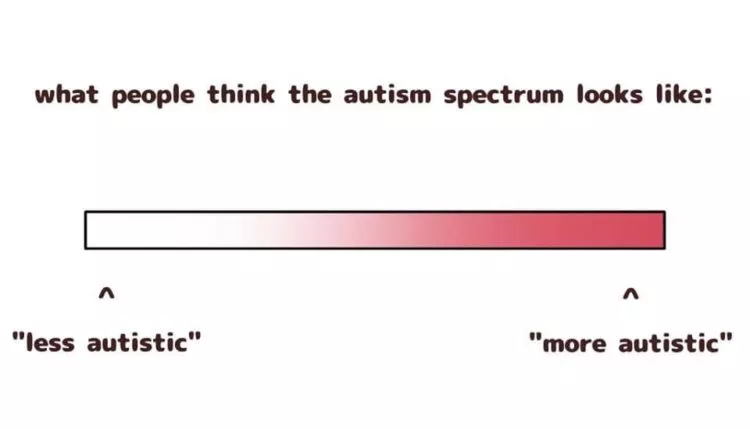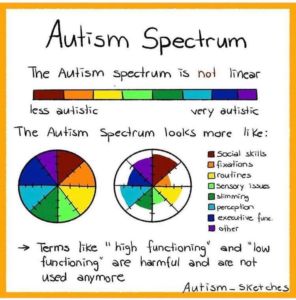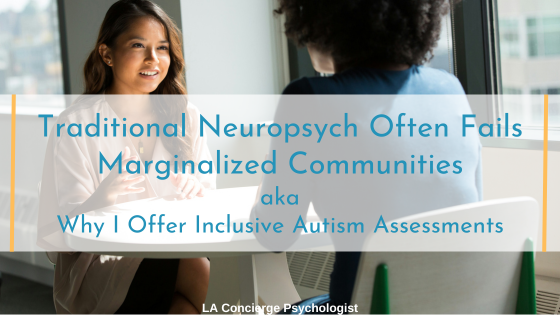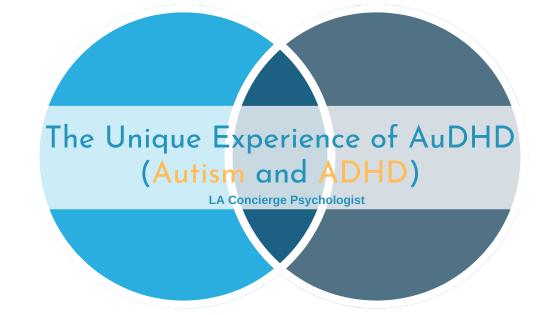What Is Autism Spectrum Disorder (ASD)?
There are many ways autism can be conceptualized. Viewed through the medical model, Autism Spectrum Disorder is a disorder to be diagnosed. A healthcare professional compares your behaviors to a list of autistic characteristics to diagnose you. These characteristics include “persistent deficits in social communication/interaction” and “restricted, repetitive patterns of behavior”. (Read about an alternative to the medical model)
Unfortunately, because diagnoses are labels that group people with similar characteristics together, they run the risk of creating and reinforcing stereotypes. Sadly, many people still think that Rain Man is the most accurate representation of adult autism. Along with these stereotypes comes a great deal of social stigma stemming from ableist attitudes. This article aims to broaden your understanding of what autism is.
Why is autism a “spectrum” disorder?
Autistic people have a wide variety of “symptoms”. Their characteristics manifest in many different ways depending on the person. This is why the saying “if you meet one person with autism, you’ve met one person with autism” is so popular. Autistic people defy a simple definition. They posses a unique cluster of strengths and struggles that manifest in many different ways.
In the past, different diagnoses captured this “spectrum” of varying presentations of autism. You may have heard of Asperger’s Syndrome or, less commonly known, Pervasive Developmental Disorder- Not Otherwise Specified (PDD-NOS). In 2013, the Diagnostic and Statistic Manual of Mental Disorders (DSM) changed to reflect the miscellany of autistic individuals. The DSM-5 renamed Autistic Disorder as Autism Spectrum Disorder (ASD).[1] They then discarded the other diagnoses of Asperger’s and PDD-NOS.
What is the autism “spectrum” in terms of neurodiversity?
To understand the concept of the autism spectrum, it might help to think of it metaphorically. Consider the characteristics of autism as colors of the rainbow. If you have ever played with a prism, you know that the light spectrum isn’t limited to just red, yellow, and blue. It’s a wide array of colors in varying intensity.
Most computers can only display 256 different colors. Standard office printers can print several thousand. The human eye can see far more— up to 2.3 million different colors. But, even that doesn’t represent the full spectrum.[2] Since distinct light waves can combine in any number of ways, the amount of unique possible colors is nearly infinite.
Let’s take this metaphor a bit further. If the autism spectrum disorder is like a rainbow, then autism spectrum disorder symptoms are like primary colors. For the sake of this exercise, let’s say that social struggles is blue. Sensory processing differences can be red. And let’s represent repetitive behaviors with the color yellow.
Two friends who lack social awareness might both be autistic. The one who also really struggles with sensory over-stimulation could be said to have an orange symptom cluster. The other, who also engages in repetitive behaviors, has more of a green symptom cluster.
Another dimension of the autism “spectrum”
But there are far more secondary colors than just orange and green because autistic characteristics manifest in many different ways. Repetitive behaviors, for example, can include big movements like bouncing, jumping, or rocking. They can also include less noticeable movements, like hair twirling, knuckle cracking, and lip licking. And you can imagine that there are an infinite number of ways someone can struggle socially!
Add to that, each behavior will vary in terms of how much it affects the individual. Many factors, such as the environment a person is in, can greatly affect the impact of a behavior. For example, an adult who works in an office where he can pace at his leisure and in private wouldn’t be very affected by this behavior. However, an autistic woman who talks at length in office meetings when the meeting leader is trying to move through agenda items may be more impacted by this social struggle.
So, even if two people struggle with both social awareness and repetitive behaviors, one might have more of a lime green symptom cluster. In contrast, another might experience symptoms that are more sea green.
Myths and misconceptions regarding autism
Being “mildly” or “severely” autistic
People sometimes ask how to detect mild vs. severe autism signs. “What does high- functioning autism look like?” they often ask. People who don’t understand ASD assume that the more “normal” someone appears, the less severe their autism is and the “lower” they must be on the spectrum. In reality, you are either autistic or you’re not. You then have a multitude of ways your individual strengths and areas of support interact with one another. And, from there, you may need different levels and types of support to accomplish your goals. 
Source: The Mighty
Functioning levels
Questions like “What are the autism spectrum levels?” and “What is the autism spectrum scale” demonstrate a growing public desire to understand autism, and that’s great! However, they also reveal a common misconception about the meaning of the word spectrum. Many people conflate “spectrum”, which denotes variety, with “gradient,” which refers to something’s severity.
So you may see people talking about someone being “high functioning” or “low functioning”. However, the spectrum is actually referring to the many different autistic characteristics (and combinations there of) that can exist across different areas. Common areas of difference are in social communication, social awareness, sensory processing, information processing, repetitive behaviors, and cognitive style.
Spectrum reflecting observable behaviors only
Another common mistake occurs when people use the term autism spectrum to describe how well someone functions in society or how noticeable their symptoms are. However, such a definition is only useful to the outside observer. From a therapeutic perspective, a better way to serve autistic people is to recognize that what matters most is how they feel inside, not how they appear. This is particularly true considering many autistic people go to great efforts to mask their symptoms. Autistic women, in particular, are skilled at masking and are thus under- or mis-diagnosed.
Many autistic people go to great lengths to appear neurotypical. However, they have many negative internal experiences that are unique to autism. For example, autistic people frequently report severe energy drain from living in a neurotypical world.
Embracing our autistic peers
Sadly, many autistic people are dismissed by society because their way of being is so different than the neurotypical population. Often times, instead of getting to know autistic people better and discovering their many positive attributes, people reject or ignore them. And if the autistic person engages in masking to try and fit in, they may miss out on getting identified and receiving needed support. Instead, they’ll continue to experience autistic burn out and likely struggle with their mental health.
When we take the time to really get to know and accept an autistic person as they are (rather than fixating on how “severe” their autism is), we access a diversity that can richly expand our worldview. We’ll also learn how to modify our neurotypical world to better accommodate their neurodiversity. In that way, autistic people will have an environment where they can utilize their strengths and be their authentic selves.
As an autism specialist, I help autistic people tap into existing resources, seek accommodations, and navigate the neurotypical world. Learn more about autism therapy here or schedule a free 20-minute phone consultation.




